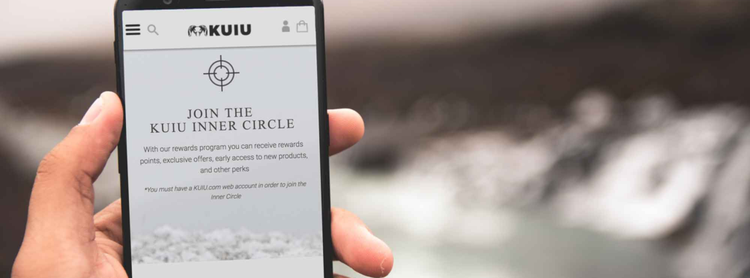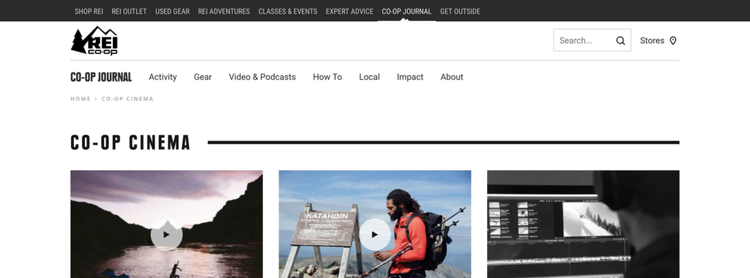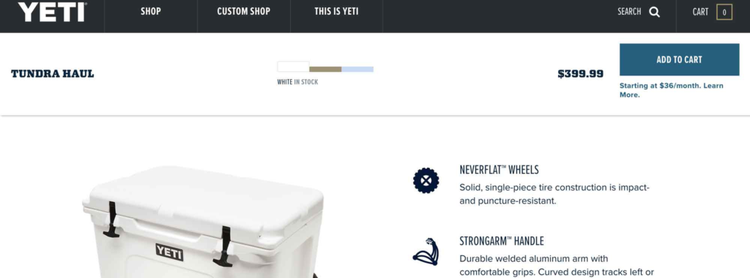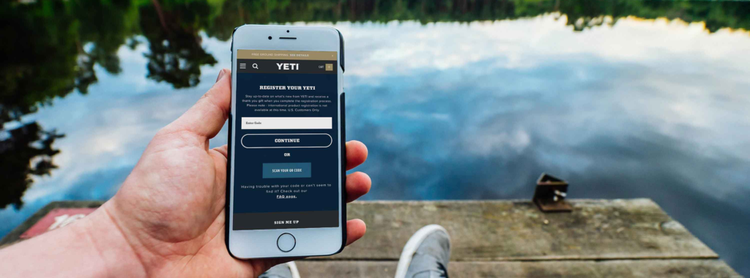9 Rules for Selling Outdoor Goods Online

When you look at the most successful outdoor brands and retailers over the years, they have a few things in common: strong brand identity, loyal following, and excellent customer service. Brands and retailers such as YETI, Patagonia, The North Face, and REI built legacy brands that continue to keep the attention of consumers across all interests, from outdoor enthusiasts to creatures of indoor comfort.
Over the years, many outdoor brands evolved from niche outdoor products into lifestyle brands with a wide array of products. You’ll see their stickers on the back of cars and laptops and people walking around with hats donning the brand’s label. By turning their brands into a lifestyle, they were able to create a community that welcomes both the occasional skier and the hike-every-single-day mountaineer.
While brands like YETI, Patagonia, and REI had a positive reputation to build off of for their ecommerce presence, they also paved the path for long-term success when selling outdoor goods online. To survive the wilderness and competition of the online outdoor industry, we came up with nine rules for selling outdoor goods online—some rules are specific to outdoor and lifestyle brands, others are general best practices for any ecommerce site to be successful.
1. Don’t Leave Loyalty to Chance
A customer loyalty program takes happy, satisfied shoppers and turns them into devoted brand evangelists. Loyal customers higher conversion rates, spend more with brands they like, and tell their friends and family about their positive experiences (often through social media). In fact, 40% of online revenue comes from repeat customers who, on average, only make up 8% of site visitors.
So, how do you get your customers to buy into a loyalty program? Take REI for example. When you land on their loyalty page, the first thing they do is list the benefits: 10% back on purchases, member-only offers, access to in-store REI “Garage Sales,” and special pricing on REI outdoor classes and events. While REI’s loyalty program requires an initial $20 fee, you earn a $20 bonus card when you sign up so it essentially pays for itself. REI also did a great job catering the benefits to both the occasional outdoors person (10% back, access to garage sale) and the enthusiast (discounts on REI outdoor classes).
A loyalty program isn’t just a one-way street. Every time a customer signs up for the program, you get rewarded with data. Besides the essentials, such as name, email, gender, zip code, date of birth, you can also ask them things like what outdoor activities or sports they like to do or what product features do they prioritize when they sign up. When you ask these ‘non-essential’ questions, explain the reason for asking these questions is to provide a more personalized experience.
KUIU, for example, started as an ultra-light outerwear company that sold gear to a specific target audience: expedition style hunters. “However, as they expanded their product line and went more mainstream, they wanted to use loyalty to learn more about their online customer base,” says Kate Atty, VP of Marketing at Clutch, a customer marketing platform.

KUIU’s email, ecommerce platform, and coupon code partners were integrated in real-time, allowing Clutch to receive data about loyalty member and non-member activities, including purchases, sign-ups, and coupon redemptions. Using the data, KUIU created personalized experiences for their “Inner Circle Members.” As a result, the Inner Circle Members average order value improved 38% and shopped 17% more compared to non-members. “Since launch, we have seen a strong correlation between membership and positive KPIs for the business,” adds Atty.
2. No Personalization Without Segmentation
As we mentioned, many outdoor brands need to cater to a wide variety of customers, especially when it comes to apparel. The key to providing a relevant, personalized experience to every customer is through segmentation. Segmentation allows you to create different customer journeys and experiences based on the customer’s previous behavior and purchase history.
Even if you don’t have customer data readily available, there are ways to personalize the experience after the customer hits the site. Don’t be afraid to simply ask customers for personal information—63% of millennial consumers agree that they are willing to share data with companies that send personalized offers and discounts.
For example, SmartWool has a sock finder questionnaire to help shoppers pick out which type of socks they need. They ask what’s their primary activity (traveling, hunting, and everyday life are a few of the choices), if they are shopping for men or women, their ideal sock height, thick or thin, and their most important features. To see the results, the customer must provide an email address.

Once they submit the answers, SmartWool now knows what activities they like, their gender, which sock features they value (color, comfort, value, etc.), and how high they want their socks. With this data along with the insights they gather each time the customer visits the site, SmartWool tailors product recommendations and promotions to their exact needs and wants.
Sarah Seifert, Director of Ecommerce at SmartWool said, “We have found the outdoor consumer requires specific fit and technical requirements for optimum performance. Socks are important gear to having the best day on the mountain or out for a run. We wanted a tool that would help our customers find their best sock quickly for their activity. Not only did our Sock Finder Tool achieve that goal, it has also provided insights and data about what matters to our customers about socks (i.e. thickness, activities, technology, support, color, or warmth). We have been able to make UX improvements with that data as well as share it with our sock design team. Conversion on orders from the Sock Finder are 71% percent higher than the overall site.”
Not only can you segment the product recommendations, but you can also use customer insights and data to create more targeted ads, such as Facebook Newsfeed Product Ads and Google Shopping Campaigns. With Facebook and Google product ads, you start by uploading a product feed that includes what you’re selling, the product’s brand, price, and availability. From there, you can create targeted campaigns that allow you to reach the right people at the right time as well as cross-sell and upsell products based on the customer’s browsing and purchase history.

For online retailers with large product catalogs, affinity-based recommendations allow brands and retailers to develop rich, holistic customer profiles using an algorithm. Affinity profiling centers around weighted scores for users based on the criteria you choose. The more interactions your customers have with your products and content, the better the recommendations align with their level of interest and needs.
By using data and insights you’ve collected, you no longer have to rely on “gut feeling” or stereotypes to target customers. You can’t always assume that every male between the ages of 25-35 living near the coast wants a surfboard, or that every college student wants a North Face backpack.
3. Always Stay Top of Mind With Customer Stories
High-quality and engaging videos are one of the best ways to nurture consumers during non-peak seasons and provide context around the products you sell.
Using REI and YETI as examples (again because they do a great job!), they both produce documentary-like videos featuring real-life customers who live the outdoor lifestyle. The videos provide context around who their shoppers are and instantly create an emotional connection between the brand and the viewer. Most YETI videos follow the lives of real-life, small-town heroes who are pursuing their passions—everything from building a baseball stadium, becoming one of the few female BBQ pitmasters, to running the family fishing lodge.

The videos accomplish two things: they keep the brand top-of-mind during non-peak months, and they successfully sell the lifestyle around the products. By focusing on the lifestyle, it feels more like a community the customer is joining when they buy your products—leading to devoted fans and repeat purchases. For example, if you walk around the office, you’ll see at least a few people wearing a Patagonia jacket or drinking from a YETI tumbler. Chances are they bought the items because they connected with the brand through other customers or content, not because they venture out into freezing temperatures or spend most of their days under the hot sun and need their beverage to stay cold.
When producing a high-quality video for your brand, think about where your products are used and the stories around those experiences. Why did this person choose this outdoor activity? How does the activity play into their everyday life? When did the activity evolve from a hobby to a passion? It’s questions like these that will help you create an engaging story to connect with the audience all year round.
Similar to creating videos, think about how you can create messaging that connects with all types of shoppers. For example, when you visit YETI’s site, one of the first messages you see is “The Tundra Haul™ is the cooler destined for professional tailgaters, frequent party hosts, or anyone who’d prefer an ice-cold beer with their backcountry view.” They want to clearly state up front that anyone that spends time outside could benefit from one of their coolers.
4. Don’t Assume One-size-fits-all for Product Pages
DYK: Nearly a quarter of customer journeys begin on the product detail pages (PDP), so you want to make sure your customers are set up for success when they land on these pages. And, where the customer is in the buying process will dictate the information they need on the PDP. To streamline the journey, one thing to consider is changing the order of information based on the visitor to emphasize or deemphasize certain sections.

If someone lands on a product page from a Facebook ad, they may need more information about the brand, the features of the product, and how it fits their needs. But, someone who’s bought from the brand before and has been browsing the site for a few minutes may just need to know what the dimensions are before completing the purchase. By providing the details they need up front, rather than making them scroll down the page, you create a smoother path to purchase.
You can also configure the product details to be dynamic based on the user affinities. Think about the type of information an avid, all-day-every-day type outdoor enthusiasts would need versus the backyard outdoorsmen versus the activity-first-timer.
For example, say two different customers are looking at the same cooler. One landed on the PDP after clicking on an Instagram ad and is looking to purchase a cooler for college football tailgating. The other shopper needs a new cooler for extended hunting trips. The football fanatic really just wants to know how many beers they can fit in the cooler. The hunter wants to know how well the insulation is and its durability for the overnight hunts (can’t have bears getting into the cooler!).

When it comes to more technical products, like sports and fishing equipment, many shoppers run into a roadblock due to lack of knowledge. Ultimately, this could lead to dissatisfied customers and more returns. To educate new customers and first-time snow gear shoppers, EVO includes detailed product data such as guides and videos on the PDP to explain things like “Rocker Technology Explained,” “How to Tune,” and “Ski Boots Size Chart & Mondopoint Conversion.” Because, if you’re not an avid snowboarder, most of these terms will sound like “holiday, hoobie, whatty?” so these guides make it easier for customers to overcome the lack-of-knowledge roadblock to making a purchase.
5. When You Have Raving Fans, Let Them Win Over New Customers
Most outdoor products serve a specific purpose and are often used regularly, so the customers need to know they can rely on the product when they need it most. The last thing a hunter needs is to come back to their truck only to find the ice melted in their cooler. Or, a skier gets to the top of the mountain, and their boot buckle breaks right before going down the slope.

For those reasons, user-generated content (UGC)—including reviews and visual content—should have a prominent place on the product detail pages. UGC is arguably one of the most powerful psychological triggers when drawing in customers. In fact, 91% of consumers read reviews regularly or occasionally and 84% trust reviews as much as a friend or family recommendation. Not only do customer reviews and UGC validate the value and quality of the product, but they also provide shoppers who are less familiar with the brand or items a holistic view of how other people use it.
Having a social feed, especially Instagram, on your product detail pages that includes images of customers using products provides you an (almost) autopilot form of marketing and builds a sense of authenticity and community around your brand. The reason we say almost autopilot is because you want to make sure that any UGC you show on the PDP is high-quality and portrays the product in the best form.
Taking UGC one step further, YETI curated a diverse group of brand ambassadors including university horsemanship instructors, professional ropers, whitetail fishers, and BBQ pitmasters. Their ambassadors often star in their videos, share photos with YETI products on Instagram, and have thousands of social media followers. By leveraging brand ambassadors to bring the brand story to life, YETI not only deepens the penetration with their current target audiences but also reaches new audiences.
6. Always Give a Clue to a Clueless Gift Giver
Gift cards are a missed opportunity for many retailers, as only 36% of Top 1000 Merchants sell gift cards online according to Internet Retailer’s Top5000Guide.com. Especially when the holidays come around, gift cards get increasingly elevated messaging and sales usually peak days before the holiday.
When someone goes to your site that is completely unfamiliar with your products and has a goal to purchase a gift, sometimes the path of least resistance is a gift card. This way, they don’t have to know all the technical terms around the products or think about what’s the best fit for the gift receiver’s needs.
What if the shopper doesn’t want to be known as the person that “always gives gift cards?” In this case, the best way to inspire the shopper is with a gift guide. The ideal gift guide includes items for both men and women, across budgets and product types. For example, REI created a holiday gift guide that allows shoppers to filter by most clicked items, budget, best guess, activity, and shipping options. It’s straightforward, and it helps the shoppers who prefer the indoors to narrow down the options for their outdoorsy friends and family.

“For brands wanting to leverage shipping to create a gift guide, allowing customers to filter items by delivery date, in-store availability and free shipping are all great options,” says Quentin Montalto, Operations Director for ShipperHQ. This ensures that once the shopper finds the perfect gift, they know it will reach the receiver in time.
To turn your gift guide into a win-win scenario, data mine it. This means pushing items that will generate the most revenue and items that may be a little over the shopper’s budget (they could spend their $40 budget on a so-so gift, or they could stretch it a little bit and get that awesome, unforgettable gift for $60).
7. Don’t Concede Customer Data Without a Fight
Many outdoor lifestyle brands sell their goods through retailers but have no data around the customers who purchase through those channels. While product registration isn’t the sexiest thing to prioritize, there’s a good reason to move it to the top of your list: Buyers who register their products are 2.3 times more likely to be “super buyers” (the top 5% of buyers).
YETI is one of many outdoor brands that uses retailers like REI, Dick’s Sporting Goods, and Walmart to sell their products. To gather information on their retail shoppers, YETI launched a product registration program on their flagship ecommerce store. In exchange for registering their products, YETI offers free stickers.

Realizing it would be expensive to keep all of the records of the registered users housed in their ecommerce platform (they’ve cultivated millions since launching the program), YETI put the records in a separate database. Blue Acorn iCi developed custom APIs to connect the database to their ecommerce platform. By doing so, customers can log into their account on YETI.com and see all the products they’ve purchased from retailers and YETI’s online store.
With the APIs connecting the database and the ecommerce platform, YETI’s marketing team can pull customer data from both their flagship store and retailer customers for onsite promotions, email campaigns, and paid social ads. Additionally, they can see which products perform best in which retail stores, allowing them to adjust merchandising as needed and push certain products in specific stores or regions that they know will return more revenue.
For brands that have customers who are “enthusiasts” and bought into the lifestyle of the brands, this strategy works well. Stickers seem like a simple incentive, but YETI customers love the stickers—they put them on cars, laptops, tumblers. The stickers provide shoppers an easy way to spot other YETI enthusiasts. Whatever your incentive is, you need to make sure it covers the cost of acquisition as well as the margin you lose when selling through a retailer. When you’re driving retail customers to shop at your direct-to-consumer online store, you lose out on that retail sale.
8. Do Take Advantage of a Sunny Situation
In the US, it’s estimated location-based ad spending will grow to $38.7 billion in 2022, up from $17.1 billion in 2017. For outdoor brands, using location data to target customers could be a gold mine if done right—how great would it be if you could target customers that tagged their location at their nearby mountain and promote your latest line of hiking boots and sleeping bags?
Additionally, if you have historical data around which days the customer does a certain activity, you can create custom marketing campaigns to reach them at the most optimal time. Location data also provides you context into their everyday lives. For example, you may know from their purchase history that they like to go hiking, but you can see based on their location data that they also like to visit the local rock climbing wall. This data can be used to create holistic customer personas for more personalized targeting and messaging.
Weather can also be leveraged to create personalized messaging and campaigns. Just like how you would see snow shovels appear on shelves at the start of winter and gardening tools appear when spring starts, you can use future weather conditions to validate a consumer’s need for a product or service. For example, Timberland sends weather-triggered emails advising subscribers that the weather forecast is good based on the shopper’s location, encourages them to go on a hike and then adds a promotional discount on hiking boots.

9. Always Be Aware of Shipping Rules
One of the downfalls of selling outdoor products online is that they can be hefty and difficult to deliver. In-store pickup offers both you and your customers an easy option for selling these items. Not only does this give customers a “peace of mind” that their orders get delivered safely, but it also gives you an opportunity to unpack the item with the customer and provide instruction on the proper use or wear. This is exactly what EVO encourages their shoppers to do when shopping online, and as a result, they lowered their return rates.
You also need to consider the rules and regulations around shipping certain outdoor items. Montalto adds, “When selling products like ammo, guns, and knives, there are legal restrictions on what can be shipped when using certain carriers or specific shipping services. In-store can help you and your customers avoid these complexities and eliminate unexpected fees, fines, or worse.”
For example, firearms cannot be shipped directly to individuals without a Federal Firearms License (FFL). But, Montalto notes that brands can leverage local FFL holders such as gun shops, pawn shops, and gun ranges to transfer the firearms to potential customers. “It’s important to be upfront to your customers about these restrictions, and what to expect post-purchase, to make for a smooth customer experience throughout the shipping process,” says Montalto.
Have Your Own Set of Rules?
Whether it’s hiking up a mountain or horseback riding through the forest, it’s always ideal to know the rules and best practices before venturing off. The same can be said for selling outdoor gear online. Though the market is competitive, these nine rules will guide you in becoming a successful outdoor and lifestyle brand. Let us know any rules you apply when selling outdoor goods online, and if you’d like to discuss optimizing your outdoor ecommerce site, please feel free to reach out to the Blue Acorn iCi team here.